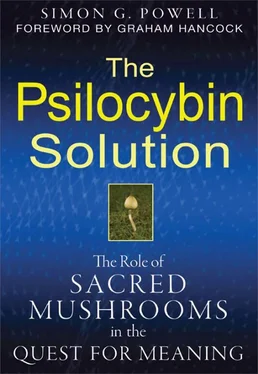The greatest reason to embrace an entheogen-based explanation for the rise of the religious impulse, however, is that it is couched in wholly naturalistic terms, therefore lending itself to scientific study. If a man claims to have had a life-changing theophany, then that is one thing. But if he bears in his hand the very method whereby he attained such an experience, then you are obliged, if you wish to determine the man’s claims, to explore and verify the means. In more ways than one, psychedelic plants and fungi must be taken seriously in terms of their role in the development of religious ideology. As intimated, their historical influence can never be overestimated.
Psilocybin mushroom use has also been associated with the Maya, whose spectacular Mesoamerican civilization dates back almost four thousand years and whose Classic period held sway from A.D. 250 to 900. At the turn of the last century, Guatemalan “mushroom stones” came to the attention of archaeologists. These Mayan relics, of which hundreds have been found, some dating as far back as 1000 B.C., were initially considered to be phallic representations, though the current consensus is that the mushroom stones reflect a Mayan religious mushroom cult.
To bolster support for this theory, it has been noted that some of the stone mushrooms are carved emerging from human figures with trancelike facial expressions. Others are linked to kneeling female figures at a metate, a kind of work surface upon which plant items are crushed. When Wasson first explored mushroom use in Huautla in the 1950s, metates were still sometimes used to grind mushrooms so that an entheogenic infusion could be made. Still other mushroom stones exhibit “toad” effigies at their base, and this creature has always been mysteriously linked with psychoactive fungi the world over, perhaps because of knowledge that certain toads exude psychoactive alkaloids from their parotid glands. (Incidentally, this odd “toady” fact might account for the fairy story The Frog Prince, as magical events happen after a frog has been “kissed.”)
Is there any other evidence that the Maya employed psilocybin mushrooms in their religion? A look at Mayan codices might shed light on this matter, yet our not-so-delightful conquering Spanish priests made that almost impossible with their blundering haste to burn everything that stood in their theological way, including virtually all Mayan scriptures. As an example of this hooliganism, consider the fact that in 1562, one Diego de Landa, a hardened Spanish priest of some frightening zeal, seized thousands of Mayan “idols” and books, and burned all and sundry as though they were worthless. Among the treasures destroyed were twenty-seven roles and signs of hieroglyphics, invaluable sources of knowledge about the Mayan civilization. According to Robert J. Sharer in The Ancient Maya, Landa commented: “We found a large number of books in these characters and, as they contained nothing in which there were not to be seen superstition and lies of the devil, we burned them all, which they regretted to an amazing degree, and which caused them much affliction.” {9} 9 6. Sharer, The Ancient Maya, 126.
Such a foolish and insensitive act has left the world with only a handful of Mayan codices with which to assess Mayan customs and beliefs. Within two of these remaining works, the Popul Vuh and the Annals of Cakchiquels, are references to psychoactive fungi, but there is no indication of the extent of their role within Mayan belief systems. In the so-called Books of Chilam Balam there is mention of trancelike states, though no mention of entheogenic plants. Again, in many Mayan relief carvings, which seem to possess a psychedelic air about them, are found scenes depicting visionary ecstasy, although plants are not explicitly shown. Some scholars have therefore rejected the notion that the Maya employed natural psychedelic agents in their religious rituals (despite the existence of the many mushroom stones) and have opted instead for the alternative view that the Maya, unlike the martial psilocybin-using Aztecs who were to follow, were of a radically different nature and temperament. However, recently discovered Mayan mural paintings have depicted fearsome-looking battle scenes, so it is not absolutely certain that these two cultures were entirely different.
If we look more closely at the actual similarity in religious belief between the Maya and Aztecs, a common historical thread connecting the two cultures can be discerned. Both peoples divided the cosmos into upper worlds and lower worlds with their respective gods. Both believed in the cyclical destruction and regeneration of the Earth, and both followed a ritual 260-day calendar. Bearing in mind these cultural similarities, it has been reasonably suggested that the Maya also utilized the mushroom as well as other psychedelic agents and that this practice influenced the nature of ancient Mesoamerican cosmology (it is even feasible that the Aztecs adopted psilocybin mushroom use from the Maya—by way of a succession of mushroom-using cultures).
It has also recently come to light, as many Mayan vases and pieces of pottery attest, that the classical Mayan elite used enemas. The objects that depict scenes of enema use date from the first millennium A.D. The daunting practice of administering enemas has been well documented in South American native peoples. In particular, it has been established that the Incas introduced psychoactive infusions into the body via enema, using bulbed syringes made from local rubber sap. Apparently, the use of an enema to introduce drug compounds into the body is almost as effective with regard to speed of action as is the method of intravenous injection. Its effectiveness with entheogens occurs because the colon is the receptive site of the enema and this is where absorption by the bloodstream occurs. A number of scholars have therefore claimed that entheogenic brews were involved in these Mayan enema rites, and thus psilocybin might well have been employed in this manner.
We should also be aware that much Mayan artwork is given over to portrayals of “vision serpents” manifesting themselves before entranced members of the Mayan nobility. As I stated earlier, to the Mayan psyche, serpents represented the entry of divine forces into normal reality, and to depict fantastically decorated serpents hovering above an enraptured individual signified a communion with the gods. Such individuals are often shown holding a special receptacle. This object is believed to either hold blood from a bloodletting rite or an entheogenic brew, both alternatives offering an effective avenue for attaining a desired visionary state of consciousness (blood loss can apparently lead to an altered state of consciousness—although I am not convinced it would be an enhanced altered state).
Taking into account all of this data, particularly the hundreds of elaborately carved mushroom stones so far uncovered, many historians are compelled to accept that the Maya utilized entheogenic flora including psilocybin mushrooms, and that the visionary realms made accessible by these plants and fungi influenced the development of the Mayan cosmological and religious outlook on reality.
Some Colombian Treasures Also Ring a Bell
Psilocybin mushroom use has also been inferred in pre-Hispanic Colombia due to the discovery of hundreds of beautiful gold objects belonging to the Sinú culture, dated to approximately A.D. 1200. These are decorative anthropomorphic works of art that characteristically carry two bell-shaped forms atop the head and were originally referred to by historians as “telephone-bell gods” (the shapes in question look like the bells found on old-fashioned telephones). Some of these bell-shaped forms are tipped with a small peak, while others are soldered onto the main body of the anthropomorphic figure by a thin “stem.” Harvard’s ethnobotanical expert Richard Evans Schultes has suggested that the bell shapes are representations of psilocybin mushrooms, which would seem reasonable since several species of psilocybin mushroom are known to flourish in Colombia, some of which possess thin stems and caps topped with a small peaked tip, or umbo.
Читать дальше










